Diastasis Recti Exercises
There are "Go To's" and "No No's" when it comes to doing Diastasis Recti Exercises.
What is Rectus Diastasis?
Diastasis means divide or separation and the rectus is the superficial or top layer of the abdominal muscle fibers.
Sometimes there is an unnatural divide between the two sides of the recutus abdominus muscle bundles and it characterizes this condition.
Who gets Diastasis Recti?
Well, it's commonly associated with pregnancy, but it can happen to men and children as well.
There is a vertical strip of connective tissue called the linea alba where the muscles of the abdomen attach, this line gets wider in the case of diastasis recti.
Various postures or movement habits can cause tissue overload which creates an unnecessary forward displacement of the abdomen.
The valsalva manuever (caused by high pressure forces), and doing diastasis recti exercises that exacerbate the condition such as lifting heavy weights or just sucking in your stomach to look better can create rectus diastasis.
What Can I do to Help or Prevent Diastasis Recti?
Core Alignment is everything!
The habit of lifting or sticking the chest out to achieve "good posture" or to help you look taller and the stomach flatter is a large contributor to diastasis recti.
Try this:
When lying or standing practice lining the ribs up over the pelvis.
The lowest part of the rib cage should stack up just above the top of the pelvis.
Imagine knitting your ribs together, not allowing them to pop out in front.
For instance, if you are standing backed up to a wall with your bottom up against it, now try to get your ribs back against the wall as well closing the space between your back and the wall.
When standing feel your tailbone reach down to the floor between your thighs and your buns getting a lifted sensation.
Avoid doing traditional crunches!
This will increase the intra-abdominal pressure, which is problematic for those with diastasis recti or at risk.
Diastasis Recti Exercises using Pilates
Pilates is a perfect complimentary exercise system for this type of condition because it works on lengthening and flattening the deep transverse abdominal muscles rather than puckering or using the more superficial rectus abdominus.
Try these exercises for a stronger healthier core and to improve your posture.
Pelvic Tilt:
This is a perfect beginner Pilates exercise to teach how to flatten and lengthen the abdomen and spine using the deep transverse abdominal muscles.
Lying flat as shown with knees bent.
Inhale to prepare and feel the breath move up and down your spine.
Exhale to let your ribs melt down into the mat flattening the back and lengthening the spine.
Inhale come back to neutral with a little space between your lower back and the mat.
Repeat for 8-10 breaths.
This Pilates exercise is a perfect one to follow the pelvic tilt. Once you learn to flatten the abdomen and keep the front of the ribcage connected you can lift the hips all the way up as shown.
Inhale to prepare.
Exhale to melt the ribs and then press through the feet as you flatten the tummy to lift the hips and back.
Once you are up make sure to keep your shoulder blades down heavy and the ribs from popping out.
Exhale to peel the spine back down one vertebra at a time.
Repeat for 6-8 repetitions.
Kneeling four point balance as a good way to do diastasis recti exercises:
This is a great way to work on your posture and form to help and prevent further rectus diastasis.
From a kneeling position and without tilting your pelvis draw your abdominals up and in like you are squeezing a gem up into your belly button.
Inhale to extend one leg and then the opposite arm, if stable keeping your core strong.
Exhale to release the arm and leg back to start.
Repeat for 4-6 repetitions each side.
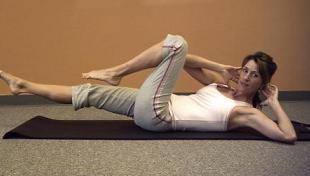
This last exercise is the most challenging for those looking to do Diastasis Recti Exercises as it involves twisting at the ribs.
Support your head as shown with your legs folded up into a 90 degree angle.
Inhale at the center.
Exhale as you keep your pelvis still and twist from the ribs bringing your opposite elbow towards bent knee.
Keep your elbows wide, your ribs knitted, and your abdomen flattening as you twist from the ribcage.
Repeat back and forth for 6-8 repetitions. Move slowly and keep the elbows wide as shown.
Recent Articles
-
Pilates after Total Knee Replacement
Apr 23, 20 06:20 PM
It's 2 yrs.post op since I had total knee replacement in both knees. In order for them to last it's recommended that you lift not more than 25 lbs. Pilates -
SI Joint Pain Improved with Pilates!
Aug 11, 17 12:29 AM
Dear Jennifer, I just wanted to reach out and thank you for dramatically improving and changing my life. About a year ago, I woke up in debilitating -
Hip pain after 4 months of Reformer Pilates
Jul 12, 17 06:44 PM
Hi, I had a total right hip replacement 8 months ago; I rehabbed really quickly, although I was also (and still am) dealing with L4 spondylolisthesis.
 | Get Instant Access to Loads of Color Pictures, Postures, and Information Designed to Increase Comfort and Happiness. Learn to Enjoy Life Again! Learn More! |
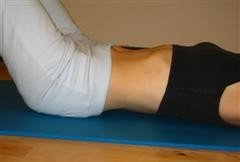
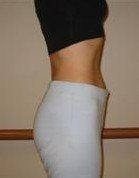
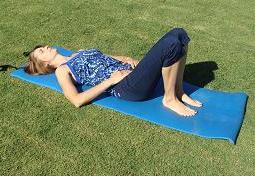
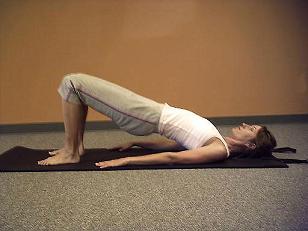
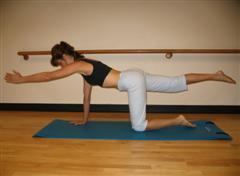

New! Comments
Have your say about what you just read! Leave me a comment in the box below.